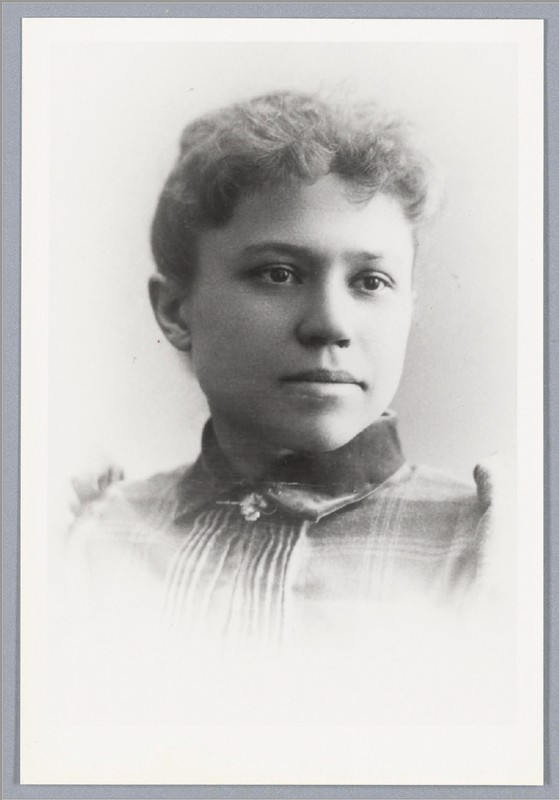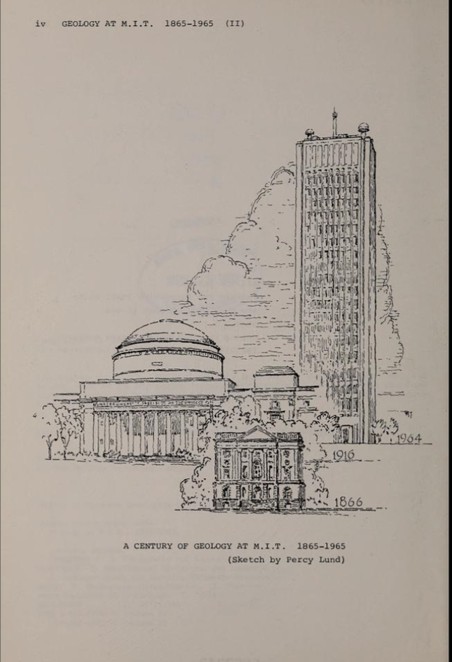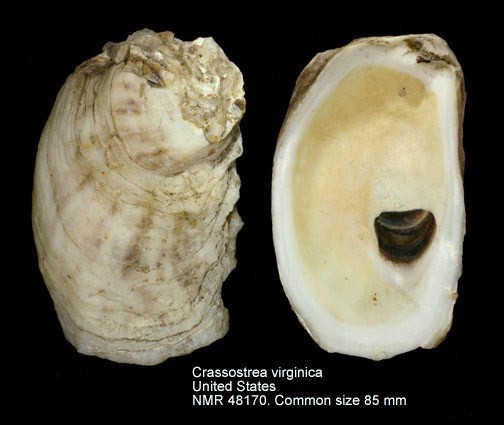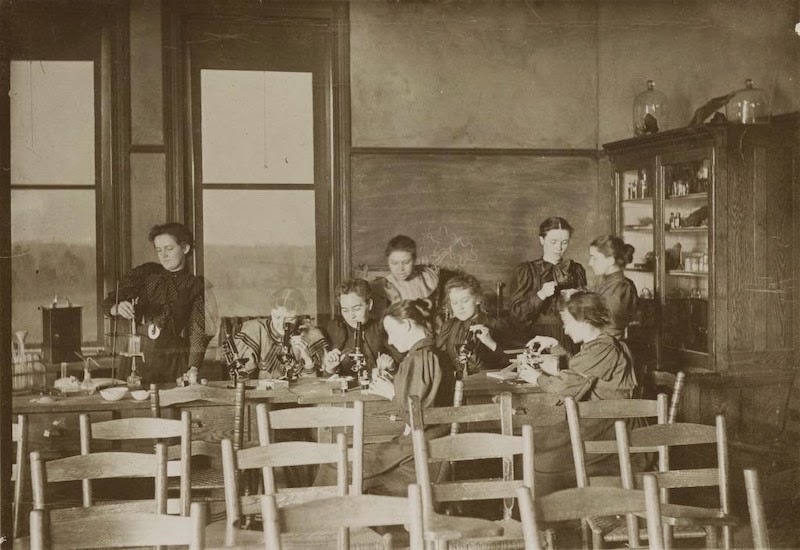Dixie Lee Bryant Lecture Hall - Honoring A Pioneering Alumna
Introduction
Text-to-speech Audio
MIT’s Green Building, designed by I.M. Pei (1940 BAR Architecture), houses the Department of Earth, Atmospheric and Planetary Sciences (EAPS) and the MIT-Woods Hole Oceanographic Institute (WHOI). Most MIT lecture halls are nameless, simply referred to by their room number: 10-250, 26-100, etc. The naming of 54-100 for Dixie Lee Bryant (1891 SB Geology), the first person to earn a degree in Geology from MIT, marks a singular honor to a pioneering woman in Earth Science.
The Dixie Lee Bryant Lecture Hall is located on the 1st Floor - which is not the ground floor. Use the elevator for the most direct route. Due to the ongoing construction, entry to Building 54 is limited. See https://capitalprojects.mit.edu/projects/building-54-infrastructure-renewal for more information.
For guidance on accessing MIT Buildings visit https://now.mit.edu/policies/campus-access-and-visitors/
Images
Dixie Lee Bryant, first graduate of Course XII, 1891.

Under Construction - Dixie Lee Bryant Lecture Hall (54-100)

A Century of Geology at M.I.T.: Beginning in Boston with the Rogers Building, then moving to Cambridge in 1916, and finally the Green Building

1891 Requirements for S.B. in Geology
%2C%201890-91%20Catalogue%20pg49.jpg)
Crassostrea virginica (formerly Ostrea virginica). The common size is 85mm (3.34 in.) Dixie’s fossil was 10.5 inches!

Dixie Lee Bryant (center, standing) with students in 1893 in the biology laboratory at the North Carolina State Normal and Industrial College

Backstory and Context
Text-to-speech Audio
Born in 1862 in Kentucky, Dixie Lee Bryant’s education was far from traditional for a young woman of the Southern US. Unlike traditional Southern schools where young ladies learned needlepoint, sewing, and manners, Dixie attended the Columbia Female Institute (CFI), which prepared young women to be intelligent partners for their husbands, not just ornamental. CFI introduced Dixie to Geology, Physics, Chemistry, Zoology, Mathematics, History, and Foreign Languages. (#8) After graduating in 1878, Dixie taught at several girls’ schools. Teaching inspired Dixie to advance her education. Since few schools in the South offered Science degrees, and none admitted women, Dixie applied and was accepted to MIT. When Dixie arrived in Boston to begin her studies in 1887, only 3% of her classmates came from the South. (#12)
During Dixie’s third year, MIT officially established the Department of Geology and approved the degree requirements. Dixie changed her major from Natural History to Geology and became the first to earn an S.B. in Geology from MIT. ((#13) Although unpublished, several journals later cite her thesis: “A Study of the Most Recent Geological History of the Tide-Water Region of Charles River.” In 1918, Hervey W. Shimer, a Paleontology professor at MIT, acknowledged Dixie as “One of the earliest persons to make a broad study of the fossil shells of Boston.” (#14)
In 1892, Dixie became the Chair of the Natural Sciences department of the newly opened North Carolina State Normal and Industrial School, which prepared teachers for work in public school systems. State Normal embraced a dual mandate to train women to be teachers and self-sufficient, independent thinkers. The school hired women with college degrees from prominent colleges like Wellesley and MIT, including MIT classmate Dr. Anna Gove, MD (Class of 1891). Dixie and her colleagues used summer vacations to complete advanced degrees and travel. Dixie often returned to Massachusetts, where she participated in programs at MIT-Woods Hole Oceanographic Institute or taught teacher training classes. Her course descriptions at the Normal reflect the cutting-edge science research presented at Woods Hole. Like MIT’s first alumna, Ellen Swallow Richards 1873 (SB Chemistry), Dixie established state-of-the-art science laboratories, expanding employment and educational opportunities for her women. (#2)
On June 7, 1901, the Greensboro Telegram reported, “Miss Dixie Lee Bryant, a member of the [faculty] of the Normal in the Science Department, was granted a leave of absence for three years to pursue her studies in biology, geology and physical geography in European universities.” (#10) In 1904, The Durham Sun reported: “A special cable from Berlin to Sunday’s Charlotte Observer says Miss Dixie Lee Bryant, of Greensboro, N.C., B.S. of the Massachusetts Institute of Technology, in Boston where she took geology as her main branch of study, has just taken a doctor’s degree in the Bavarian University of Erlangen, of a degree “magnum cum laude.” She is the first woman student doctor of that university.”(#11) The news appeared in local newspapers and over a dozen newspapers from New York to California.
The State Normal’s catalogs from the early 1900s indicate that Dixie was the first and only faculty member with a Ph.D. and remained with the school until 1905. She then taught at the Hyannis Normal School in Massachusetts for a year before moving to Chicago, where she taught science at a coeducational secondary school. Later in life, when asked about her accomplishments Dixie “chose two: first, that she was a pioneer among women in getting a college education; second, that she was privileged to put all of her preparation and efforts, for the first nine years of its existence, into helping to form a real college for Southern girls at the State Normal and Industrial School in Greensboro.” (#2)
The Green Building, completed in 1964, is named after donors Cecil and Ida Green. With generous donations from Shell and other donors, in 2019, MIT began significant renovations on the Green Building. An August 2019 MIT News article reported that 54-100 would be named “Shell Auditorium.” However, “the idea of having a prominent space in the Green Building named after a fossil fuel company triggered a strong reaction from students and other members of the EAPS community who felt that it was inconsistent with what the department stands for. What would it imply about us as a leader in climate science?”(#17)
After a series of meetings between the EAPS/MIT community and the Shell US External Relations team, “it was jointly decided that [...] the choice of the name would be determined by a transparent, department-wide process, reflecting current community values.”(#17) The result was a remarkably open process where community members submitted candidate names, EAPS stakeholders developed a slate of recommendations, and Shall made the final selection. The choice of Dixie Lee Bryant fittingly honors her enterprising spirit.
Sources
- “A Major Expansion for the Green Building | MIT News | Massachusetts Institute of Technology.” MIT News | Massachusetts Institute of Technology, 22 Aug. 2019. https://news.mit.edu/2019/major-expansion-green-building-0822. Accessed 10 Mar. 2023.
- Delta Kappa Gamma Society. Eta State (N.C.), and Cordelia Camp. Some Pioneer Women Teachers of North Carolina. [s. l.: The Society], 1955. https://hdl.handle.net/2027/uva.x001260437. Accessed 10 Mar. 2023.
- Dean, Pamela. “Learning to Be New Women: Campus Culture at the North Carolina Normal and Industrial College.” The North Carolina Historical Review, vol. 68, no. 3, 1991, pp. 286–306. JSTOR, http://www.jstor.org/stable/23519484. Accessed 17 Mar. 2023.
- Bryant, Dixie Lee, first graduate of Course XII, 1891. Robert R. Shrock papers (MC-0427), Box: 9, Folder: 37. Massachusetts Institute of Technology. Libraries. Department of Distinctive Collections. https://dome.mit.edu/handle/1721.3/190124.
- “Dixie Lee Bryant, Trailblazer for Women in Science | MIT Department of Earth, Atmospheric and Planetary Sciences.” MIT Department of Earth, Atmospheric and Planetary Sciences | MIT Department of Earth, Atmospheric and Planetary Sciences, 31 May 2021. https://eapsweb.mit.edu/news/2021/dixie-lee-bryant-trailblazer. Accessed 10 Mar. 2023.
- Collection of Shrock, Robert R. (Robert Rakes), 1904-1993. “Bryant, Dixie Lee, first graduate of Course XII, 1891.” https://dome.mit.edu/handle/1721.3/190125. Accessed 14 Mar. 2023.
- “Columbia Female Institute | Historic Maury County.” Historic Maury County, 10 Jan. 2019, https://historicmaurycounty.com/tag/columbia-female-institute/. Accessed 9 Mar. 2023.
- “Columbia Female Institute; Mr. Smith Comes to Town.” The Daily Herald | Columns | Opinions, 13 June 2016, Columbia Female Institute; Mr. Smith comes to town. https://www.columbiadailyherald.com/story/opinion/columns/2016/06/13/columbia-female-institute-mr-smith/25675639007/. Accessed 9 Mar. 2023.
- Lawrimore, Erin. “Bryant, Dixie Lee | NCpedia.” NCpedia Home Page | NCpedia, 2014, https://www.ncpedia.org/biography/bryant-dixie-lee. Accessed 11 Mar. 2023.
- “Miss Dixie Lee Bryant Given Leave of Absence For Three Years - Prof. T. Gilbert Pearson Elected to Fill Vacancy.” Greensboro Telegram, 7 June 1901.
- “Miss Bryant Earns Degree.” The Durham Sun, 18 July 1904.
- MIT President’s Report 1887-1888. https://libraries.mit.edu/archives/mithistory/presidents-reports/1887.pdf. Accessed 11 Mar. 2023.
- MIT President’s Report 1891-92. https://libraries.mit.edu/archives/mithistory/presidents-reports/1891.pdf. Accessed 21 Apr. 2023.
- Shimer, Hervey W. “Post-Glacial History of Boston.” Proceedings of the American Academy of Arts and Sciences, vol. 53, no. 6, 1918, pp. 441–63. JSTOR. https://doi.org/10.2307/25129998. Accessed 14 Mar. 2023.
- Shrock, Geology at MIT 1865-1965, Vol I & Vol II (pg 398). https://archive.org/details/geologyatmit186502robe/page/n29/mode/2up?q=Dixie+Lee+Bryant. Accessed 14 Mar. 2023. [Link to books]
- “State Normal and Industrial School for Women.” The News and Observer, 22 May 1892.
- Van der Hilst, Robert D., et al. “What’s in a Name? | MIT Department of Earth, Atmospheric and Planetary Sciences.” MIT Department of Earth, Atmospheric and Planetary Sciences | MIT Department of Earth, Atmospheric and Planetary Sciences, 1 June 2021, https://eapsweb.mit.edu/news/2021/whats-in-a-name.
1. Bryant, Dixie Lee, first graduate of Course XII, 1891. Robert R. Shrock papers (see above)
2. Under Construction photo by Suzanne L. Cooper, May 2023
3. Robert Shrock, Geology at MIT 1865-1965, Vol II (pg iv). (See above)
4. 1891 Requirements for S.B. in Geology, MIT Course Catalogue 1891-92. (See Above)
5. Crassostrea viginica, image by Joop Trausel and Frans Slieker. https://www.marinespecies.org/aphia.php?p=image&pic=66404&tid=140657. Accessed 21 Apr. 2023.
6. Dixie Lee Bryant (center, standing) with students in 1893 in the biology laboratory at the North Carolina State Normal and Industrial College. Martha Blakeney Hodges Special Collections and University Archives, UNCG University Libraries. https://www.ncpedia.org/biography/bryant-dixie-lee. Accessed 20 Apr. 2023.
